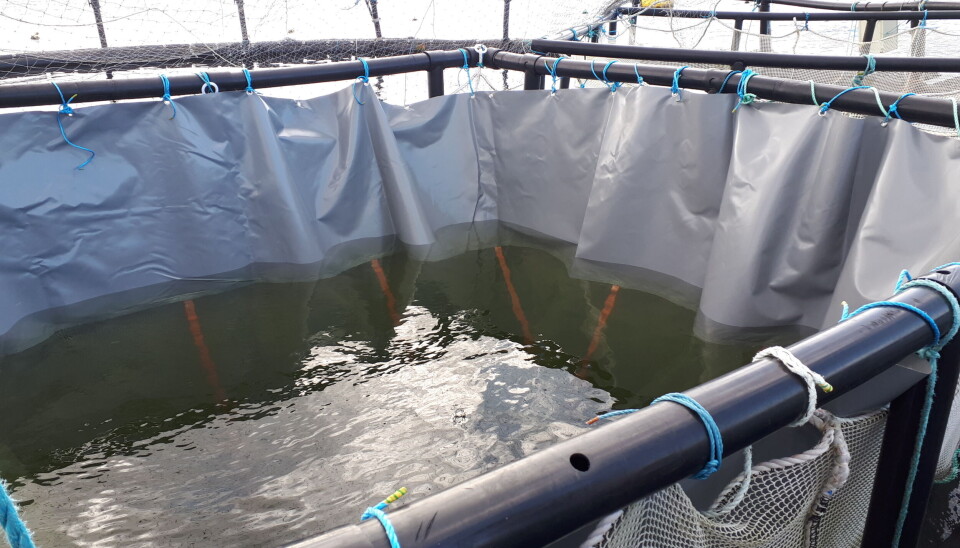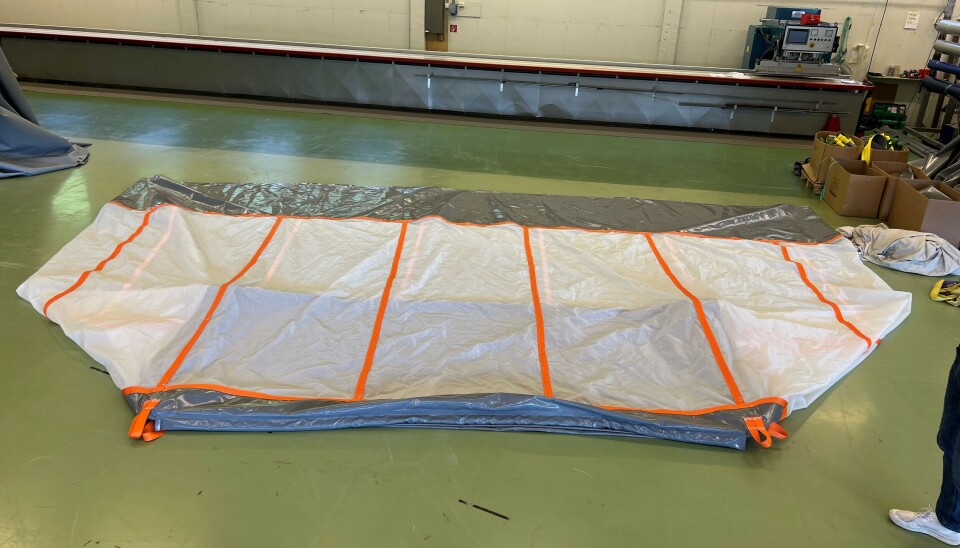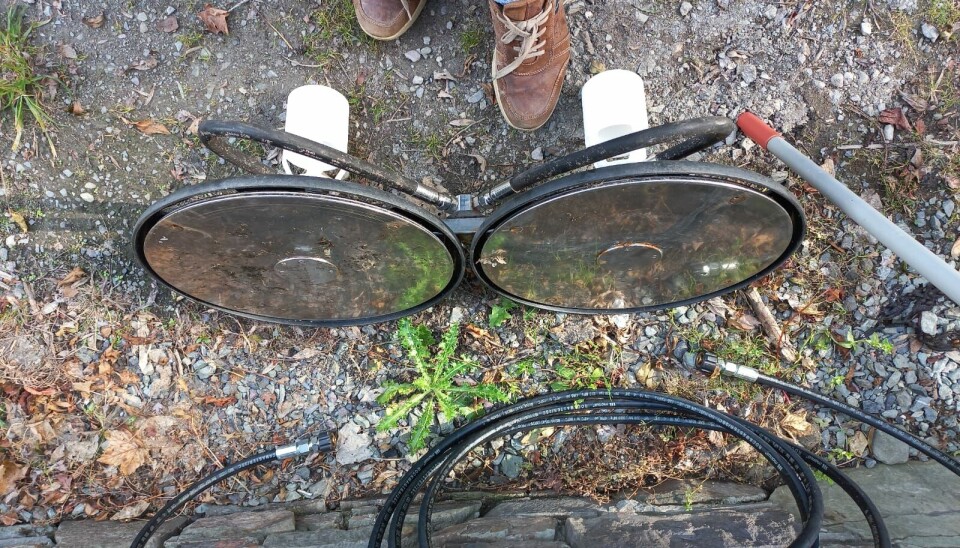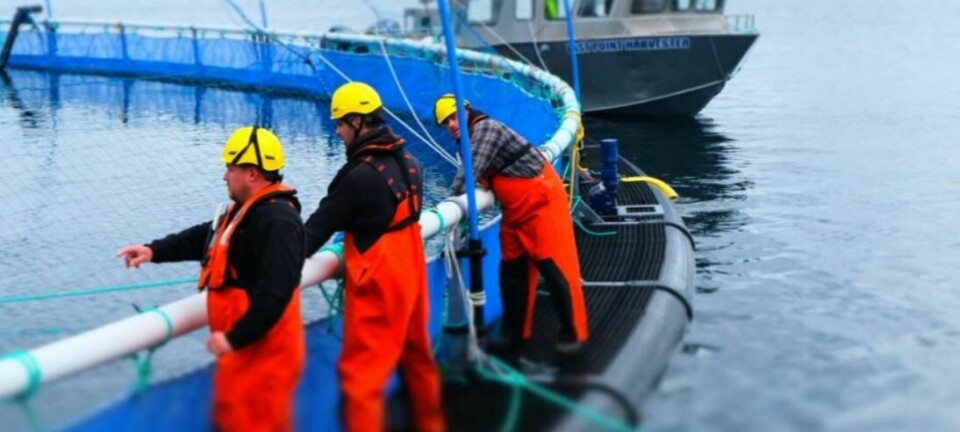
Farming partner sought after trial ‘proves concept’ of lice-proof mesh
Scottish R&D company keen to take next step in development of retrofit system following success with smolts at Irish test site
A Scottish company that has developed a porous semi-closed containment system for salmon farming is seeking a farming partner for commercial trials following a successful proof-of-concept trial in Ireland.
Salar Pursuits, a research and development business run by Andrew and Colette Bett, uses a 150-micron nylon mesh to create a retrofit bag/enclosure that sits inside a standard net pen. The mesh is fine enough to keep out sea lice nauplii and micro jellyfish but allows water to pass through, reducing the need for water to be pumped into the enclosure to maintain dissolved oxygen (DO) levels. With sea water flowing through the fine mesh, the pressure difference is equalised across the mesh material.
Fish faeces and uneaten feed are trapped in the base of the bag instead of falling to the seabed and can be removed for use as fertiliser or bio-fuel.
Salar Pursuits had its Smoltscreen™ system tested in a trial at the Marine Institute of Ireland’s site in Cashel Bay, Galway, from 15 November 2022 to 6 March 2023.
Sentinel pens
A sentinel pen incorporating a retrofit fine 150-micron mesh Smoltscreen enclosure with a volume of 49 cubic metres was used alongside a sentinel control pen with standard 18 mm knotless nylon netting with a volume of 64m³.
The Smoltscreen pen and control pen were each stocked with 400 organic smolts at an average weight of 72 grams.

Although limitations on the availability of the site meant that the 15-week trial took place during a known period of low challenge from sea lice and from zooplankton and micro jellyfish, the Smoltscreen still showed positive results.
Smolts were found with sea lice in the control pen on four occasions and none were found in the Smoltscreen, showing that sea lice nauplius larvae cannot enter through a 150-micron nylon woven mesh.
While it was also a low period of jellyfish challenge in Cashel Bay, gill histology conducted by PHARMAQ Analytiq Ireland did find one micro jellyfish in the gills of one smolt from the control pen, and none in the Smoltscreen fish.
Salar Pursuits said micro jellyfish are no smaller than 300 micron and therefore a 150-micron nylon mesh would be expected to protect salmon from micro jellyfish infestations.
Fish health
Fish health performance was similar in the Smoltscreen pen and control pen.
At the fourth Marine Institute fish sampling on 23 February the average weight of the Smoltscreen smolts was 149g (60-290g) and the average for the control pen was 151g (59-310g).
During the trial three smolts died in the control pen and there were no mortalities in the Smoltscreen pen.
From the start of the trial until 6 December the Smoltscreen was supplied with oxygenating water by a stainless-steel submersible pump suspended 10 metres under the site’s feed barge, filtered through a 150-micron titanium basket strainer and delivered to the Smoltscreen enclosure through a four-inch diameter pipe. During that period DO was maintained at between 71-88%.

The Smoltscreen was cleaned weekly with a hand controlled two-disc power washer but after time the washer developed a problem that led to it operating sub-optimally until new nozzles to be delivered. During that period a second pump was deployed, inside the Smoltscreen pen, to draw water through the mesh. This maintained DO at 77-89% until the washer was repaired on 20 February and optimal cleaning was restored.
Salar Pursuits said an important learning from this incident was that the Smoltscreen operated well when it was cleaned weekly and this is the benchmark for maintaining optimum conditions for the salmon, using the latest trackless ROV power washing cleaners.
Commercial trial
The company’s next step is to conduct a commercial trial in a 50, 80 or 120-metre pen, with all elements - pumps, filters, and waste removal - scaled up to meet water quality requirements for commercial stocking density.
As well as the semi-closed Smoltscreen, Salar Pursuits has developed a porous semi-open system called Bloomshield™ to protect fish from toxic algal blooms.
Andrew Bett said: “We believe that fine mesh enclosures and curtains with an optional combination of column pumps and/or submersible pumps with basket strainers are potential climate resilient solutions for cost efficient and sustainable salmon and sea trout aquaculture.
“We are now offering our patented Smoltscreen and Bloomshield systems for commercial trials.”
Read more about the Smoltscreen trial, including a six-page report by PHARMAQ Analytiq Ireland, in the upcoming issue of Fish Farming Expert magazine.






















































